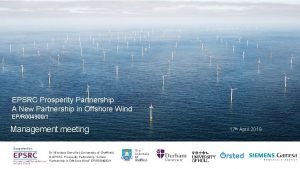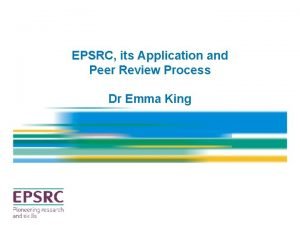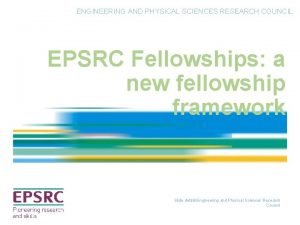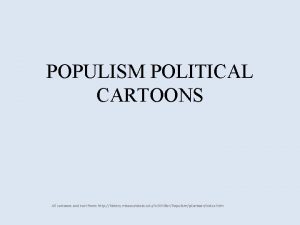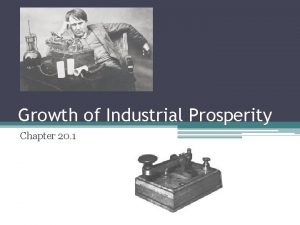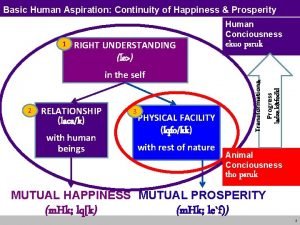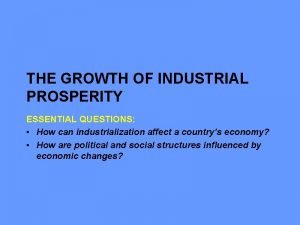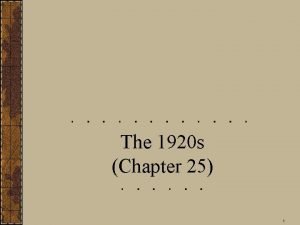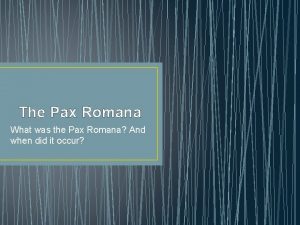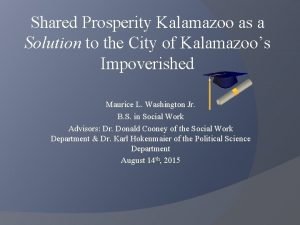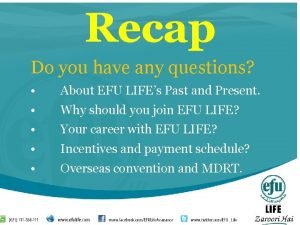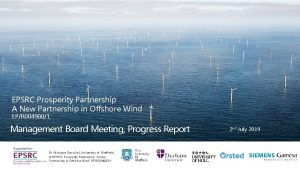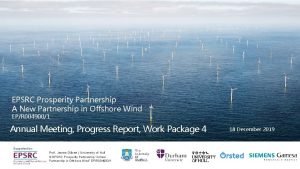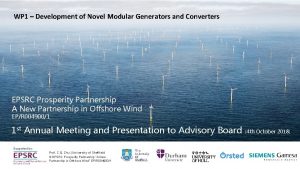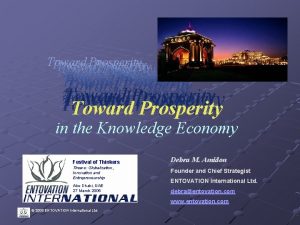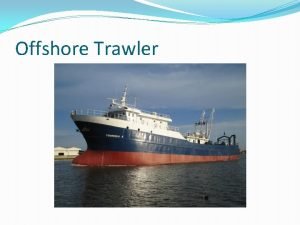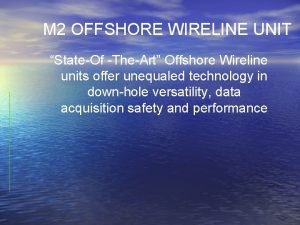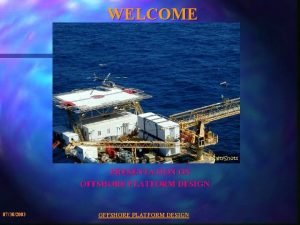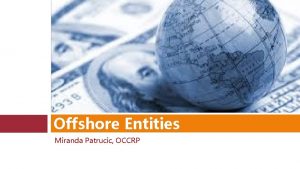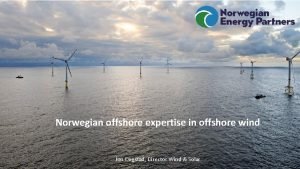EPSRC Prosperity Partnership A New Partnership in Offshore



















- Slides: 19

EPSRC Prosperity Partnership A New Partnership in Offshore Wind EP/R 004900/1 1 st Annual Meeting and Presentation to Advisory Board Supported by: Prof. James Gilbert | University of Hull © EPSRC Prosperity Partnership “A New Partnership in Offshore Wind” EP/R 004900/1 4 th October 2018

WP 4. Investigation of novel blade and foundation technology 4. 1 Modelling, design and manufacture of novel blade structures 4. 2 Embedded sensors for whole lifetime structural monitoring of blades 4. 3 Numerical modelling of drag anchors for cable risk assessment 4. 4 Improved assessment of installation risks and in-place stability of lightweight inter-array cables for offshore renewable installations Supported by: Prof. James Gilbert | University of Hull © EPSRC Prosperity Partnership “A New Partnership in Offshore Wind” EP/R 004900/1 2

Recruitment WP 4. 1 Modelling, design and manufacture of novel blade structures Research Software Developer due to start 1 st Jan. PDRA originally due to start 1 year after the software developer but starting recruitment now. WP 4. 2 Embedded sensors for whole lifetime structural monitoring of blades PDRA 1 (Integration of optical fibres during manufacture) - due to start on 31 st October. PDRA 2 (fibre optic sensors) - Candidate identified and interviewed but need to re-advertise at new band. WP 4. 3 & WP 4. 4 Adverts and targeted recruitment ongoing following unsuccessful recruitment round Appointed candidate was unable to take up the position due to health issues Further candidate with correct background should be applying this week Supported by: Prof. James Gilbert | University of Hull © EPSRC Prosperity Partnership “A New Partnership in Offshore Wind” EP/R 004900/1 3

WP 4. 1 Modelling, design and manufacture of novel blade structures Structural optimization - Bio-inspiration Bones grow and continually adapt in response to mechanical stress. They are optimized to resist a complex combination of many loads. They are strong but lightweight. + + ++ + Supported by: Prof. James Gilbert | University of Hull © EPSRC Prosperity Partnership “A New Partnership in Offshore Wind” EP/R 004900/1 4

WP 4. 1 Modelling, design and manufacture of novel blade structures Bone modelling Ultra-high resolution finite element analysis allows us to investigate macro- and micro-level bone geometry. Adaptive remodelling, combining multiple loading scenarios, optimizes the structure. ΣFi Supported by: Prof. James Gilbert | University of Hull © EPSRC Prosperity Partnership “A New Partnership in Offshore Wind” EP/R 004900/1 5

WP 4. 1 Modelling, design and manufacture of novel blade structures Structural optimization - application to blade design new core options 3 D fully optimised 3 D regular lattice 3 D irregular lattice + Supported by: Prof. James Gilbert | University of Hull © EPSRC Prosperity Partnership “A New Partnership in Offshore Wind” EP/R 004900/1 6

WP 4. 1 Modelling, design and manufacture of novel blade structures Identify appropriate blade models – full/sections Identify candidate materials & determine properties Establish load cases Identify structural constraints Software enhancement – anisotropic materials & optimisation algorithms Structural optimisation Quantify performance improvement Determine manufacturability constraints Validate models - existing & new structures Supported by: Prof. James Gilbert | University of Hull © EPSRC Prosperity Partnership “A New Partnership in Offshore Wind” EP/R 004900/1 7

Progress against tasks for each Work Package and plan for next 3 months WP 4. 1 Structural optimisation • Discussed with SGRE UK, Hamburg and Denmark. • Focus changed from optimisation of inserts (as in proposal) to entire blades (as it offers greater cost saving potential). • Initial optimisation will be conducted on public domain reference blade (NREL 100 m or Sandia Labs 100 m). Design and load case data for both blades obtained and initial processing complete. Next 3 months: • Research Software Developer induction and PDRA recruitment Supported by: Prof. Z. Q. Zhu | University of Sheffield © EPSRC Prosperity Partnership “A New Partnership in Offshore” Wind EP/R 004900/1 8

WP 4. 2 Embedded sensors for whole lifetime structural monitoring of blades Manufacture Embed ‘nervous system’ of fibre optic strain/temperature sensors Resin infusion Curing temperature Residual stress Transport and installation Operation Stress history Multi-axis stress Thermal cycling Impacts Digital twin Improved lifetime prediction Understanding of manufacture -operation parameter interaction Supported by: Prof. James Gilbert | University of Hull © EPSRC Prosperity Partnership “A New Partnership in Offshore Wind” EP/R 004900/1 9

WP 4. 2 Embedded sensors for whole lifetime structural monitoring of blades Challenges Focus is on extracting through-life strain and temperature measurements • Identify appropriate sensor and signal processing technologies • • Balance spatial and strain/temperature resolution and dynamic range Balance requirements during manufacture and operation Robustness to survive manufacture and service System cost • Optimise number and arrangement of sensors • Direction, depth, redundancy (inc. blade repair) • Develop signal processing techniques to decompose strain and temperature measurements • Integrate into blade manufacturing process • Evaluate system performance Supported by: Prof. James Gilbert | University of Hull © EPSRC Prosperity Partnership “A New Partnership in Offshore Wind” EP/R 004900/1 10

WP 4. 2 Embedded sensors for whole lifetime structural monitoring of blades Other sensors 2. 2. Integrating data from multiple on-turbine sensor networks to detect the most critical failure modes of wind turbine blades Optimal placement of sensors 4. 2. Embedded sensors for whole lifetime structural monitoring of blades 2. 3 Fibre-optic integrated sensors for blade Structural Health Monitoring Sensor data Scaled blades Full sized blades? Supported by: Prof. James Gilbert | University of Hull © EPSRC Prosperity Partnership “A New Partnership in Offshore Wind” EP/R 004900/1 Stress models 4. 1. Modelling, design and manufacture of novel blade structural inserts 2. 5. Predicting critical failures in wind turbine blades by modelling populations of wind turbines

WP 4. 2 Embedded sensors for whole lifetime structural monitoring of blades Develop resin infusion/curing test rig Evaluate manufacture on full scale blade Evaluate inmanufacture measurement Evaluate performance on small scale blade model Field test strain sensors on full scale blade Devise and evaluate signal decomposition techniques Define system requirements and constraints Evaluate available sensor systems Establish appropriate load, stress and thermal models Integrate fibres into manufacturing process Liaise with sensor producers Assess alternative fibre arrangements Define Test regime Uo. H and/or LVV (Sheffield) Supported by: Prof. James Gilbert | University of Hull © EPSRC Prosperity Partnership “A New Partnership in Offshore Wind” EP/R 004900/1 12

Progress against tasks for each Work Package and plan for next 3 months WP 4. 2 Embedded Sensors • Discussed with SGRE UK, Hamburg and Denmark – primarily focus on manufacturing issues. • Working with SGRE to identify kit suitable for bench top composite casting set up. Potential to use equipment from SGRE training centre. • Involved additional investigator (Kevin Fancey) with composite manufacture and evaluation expertise. Once PDRAs in Post: • Conduct literature review/supplier discussions to assess current fibre optic sensing systems capabilities • Identify/procure bench top casting system components Supported by: Prof. Z. Q. Zhu | University of Sheffield © EPSRC Prosperity Partnership “A New Partnership in Offshore” Wind EP/R 004900/1 13

WP 4. 3 Numerical modelling of drag anchors for cable risk assessment Supervisors: Prof Charles Augarde & Dr Will Coombs, Ørsted Lead: Laurence Cross Current approaches to determine drag anchor behaviour when assessing the risk to windfarm cables of the anchoring of vessels close to the cable route are often based on outdated anchor penetration models and data from trials undertaken many years ago. Concerns exist that for some types of seabeds (e. g. soft clays) the guidance, on fluke penetration and drag length, could be overconservative. Knowledge of the performance of drag anchors is necessary to assess the risk of damage to cabling laid on or in the seabed. Increasing numbers of offshore installations for renewable energy means increased cabling to carry the electricity to land hence prompts the need for improved risk assessment procedures. In this project, advanced numerical modelling will be applied to the problem of drag anchor embedment in the seabed. The numerical modelling will be based on the Material Point Method (MPM), which provides an efficient means to model very large deformations, uses existing finite element technology (e. g. constitutive models for the seabed soils) and is ideal for the modelling of soil-structure interaction. The modelling will be validated against existing field data, and also potentially against laboratory trials at Dundee University. Two situations will be modelled: (a) “emergency anchoring” where a vessel deploys an anchor while travelling; (b) a moored vessel anchor breakout. Supported by: Prof. Z. Q. Zhu | University of Sheffield © EPSRC Prosperity Partnership “A New Partnership in Offshore” Wind EP/R 004900/1

Progress against tasks for each Work Package and plan for next 3 months WP 4. 3 Numerical modelling of drag anchors for cable risk assessment • Potential student identified • Undertake a literature review of existing techniques for assessment of the deployment of drag anchors and long-term capacity/breakout potential of anchors for a variety of soil conditions. • Make contact with other researchers and possibly anchor manufacturers for data that could be later used for validation of the numerical model. • Extend the existing material point method code to include dynamic effects and soil-fluid coupling. • Implement a suitable boundary condition enforcement method between the drag anchor and the soil. • Begin validation. Supported by: Prof. Z. Q. Zhu | University of Sheffield © EPSRC Prosperity Partnership “A New Partnership in Offshore” Wind EP/R 004900/1 15

WP 4. 4 - Improved assessment of installation risks and in-place stability of lightweight inter-array cables for offshore renewable installations Supervisors: Prof Charles Augarde & Dr Will Coombs Particular issues exist with the installation of lightweight cabling for offshore renewables installations, e. g. inter-array lines in certain seabed conditions. Cabling made using low specific gravity materials such as aluminium is often difficult to bend into place in a trench in which the seabed deposits are effectively fluidised due to the trenching operation. The initial stability following installation is then affected by soil settlement above and around the cable, and by vibrations transmitted along the cable. It is currently very difficult to predict behaviour and new tools are needed to avoid problems in the future. In this project, numerical techniques will be developed to model the installation and post-installation of a single representative cable in a soft seabed material Supported by: Prof. Z. Q. Zhu | University of Sheffield © EPSRC Prosperity Partnership “A New Partnership in Offshore” Wind EP/R 004900/1

WP 4. 3/4. 4 Both projects have been scoped and approved with Ørsted. Legal agreements will be put in place once all projects have been defined A related Ph. D student started on the 1 st October 2018 on a Mexican government scholarship. Research on one of the projects from the initial funding application that was not taken forward as part of this project after discussions with Ørsted. The student will be developing constitutive models for seabed sediments that are on the boundary of conventional soil mechanics. Supported by: Prof. Z. Q. Zhu | University of Sheffield © EPSRC Prosperity Partnership “A New Partnership in Offshore” Wind EP/R 004900/1

Risks and Opportunities Risks • PDRA/Ph. D student Recruitment • WP 4. 1 Ability to source components for sensor system and bench top casting rig within budget Opportunities • Link to Supergen ORE Hub and other projects for improved loading models for larger blades Supported by: Prof. James Gilbert | University of Hull © EPSRC Prosperity Partnership “A New Partnership in Offshore Wind” EP/R 004900/1 18

Outcomes and Outputs Supergen ORE Hub • £ 5 M (+ potential further £ 4 M) funding to support fundamental research in Wave, Offshore Wind and Tidal Energy • Looking at future large scale deployment scenarios, ‘virtual sites’, modelling and design techniques with emphasis on floating structures • Opportunities to shape and respond to future flex funding calls Supported by: Prof. James Gilbert | University of Hull © EPSRC Prosperity Partnership “A New Partnership in Offshore Wind” EP/R 004900/1
 Epsrc prosperity partnerships
Epsrc prosperity partnerships Security and prosperity partnership of north america
Security and prosperity partnership of north america Epsrc response to reviewers
Epsrc response to reviewers Epsrc fellowships
Epsrc fellowships Populist cartoons
Populist cartoons Augustus caesar pax romana
Augustus caesar pax romana Prosperity and depression worksheet answers
Prosperity and depression worksheet answers Turning point of business cycle
Turning point of business cycle What is basic human aspiration
What is basic human aspiration People planet prosperity
People planet prosperity The growth of industrial prosperity
The growth of industrial prosperity Prosperity oil
Prosperity oil What is meant by continuity of happiness
What is meant by continuity of happiness The growth of industrial prosperity
The growth of industrial prosperity Chapter 14 postwar prosperity and civil rights
Chapter 14 postwar prosperity and civil rights Prosperity deals
Prosperity deals Postwar prosperity and civil rights
Postwar prosperity and civil rights When did the pax romana begins.
When did the pax romana begins. Shared prosperity kalamazoo
Shared prosperity kalamazoo Efu prosperity for life
Efu prosperity for life
